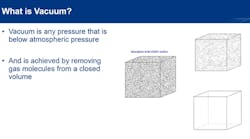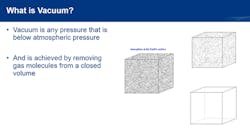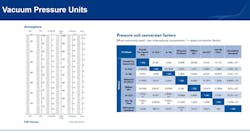Weston Benton, Quincy Compressor’s business line manager, has used his mechanical engineering background to focus solely on the vacuum industry during his career. Every year, manufacturing companies waste thousands of dollars on inefficient vacuum equipment that is not properly maintained, sized poorly or in need of replacement. During the live Q&A portion of the webinar, "The 5 Myths of Industrial Vacuum Systems," Benton explored areas of opportunity to make existing vacuum systems more efficient.
PS: Are there reasons that I might not want 29.9 inches of vacuum?
WB: There are a few different reasons you may not want 29.9 inches of vacuum. The first being the deeper you go in vacuum, the more you magnify your leaks, the more effect it's going to have on your system. The second reason is the deeper you go in vacuum, the more energy you're going to consume. There's no point in wasting energy to create a differential that you're not going to use. So, the most efficient way possible to run a system is to run it at the least vacuum level that you can to have a good process.
PS: How do I know if my vacuum gauge is reading absolute or gauge scale?
WB: That's often a source of confusion for a lot of people. The easiest way to determine if you're looking at a gauge that reads an absolute or gauge scale is look at what it does when everything is turned off. So, we've talked about with the gauge scale, local atmospheric pressure is zero. If you turn everything off and the system's open to atmospheric pressure and your gauge reads zero, then you know you're looking at something that reads an engaged scale. If you turn everything off and your gauge's reading something in the 29 to 30-inch range, then you're looking at an absolute scale gauge.
PS: How do I know if I have leaks?
WB: It is difficult to detect leaks. The best way to do it is what we call a pump-down test. What we do is we will close the valve at the process, use the pump to pump down the entire system, and then valve off the pump itself and see how long it takes for the pressure to rise in the system. When we do that, we can do some calculations on the time it takes for the pressure to rise and figure out what the leak rate is.
PS: What's the best method to determine that system leak rate?
WB: Similar to what we were just talking about doing the pump down test. What we can do is valve it off and do the calculation on it. Or if we can run a known process, knowing exactly how much flow rate it takes, then we can calculate what the pump is doing and determine how much of that is coming from leaks.
PS: What is the difference between ACFM and SCFM?
WB: The difference is actual cubic feet per minute and standard cubic feet per minute. ACFM is one cubic foot of actual volume at whatever conditions we're looking at. In vacuum, we're looking at inlet conditions of the pump, so it would be one cubic foot at a certain vacuum level versus SCFM would be the same volume or the same amount of air, the same mass of air that would occupy one cubic foot at a standard atmospheric condition. I know that's a bit of a technical difference, but ACFM is more of a volumetric flowrate and SCFM is more of a mass flowrate.
PS: How do I know if my pump's piping is appropriate?
WB: That's a great question. That goes back to the pressure loss that we were talking about through the piping. Another thing that causes pressure loss in addition to leaks is having inadequate sized pipes. If our piping is too small, we're causing restrictions through the piping, and we're not going to get all of our vacuum level. So what we can do is put gauges in line and be able to look at the different vacuum levels, especially from the difference between the vacuum level at the pump and the vacuum level at the process. And if there's too much of a difference between those, then we know we probably need to look at upgrading the piping system.
PS: How well do the common customer problems that you see day in and day out line up with these myths? I mean, are these all addressing the most common problems you see out there, or are there some other problems that are just as common which might not be as beholden to the myths, which may have more straightforward answers to them.
WB: A lot of times the issues we see with customers, the day-to-day problems they're seeing will boil down to one of these issues. It may not be seen like that initially, sometimes they're just saying, "I'm not getting enough vacuum," or, "My pump isn't quite big enough. I'm not getting enough flow rate." But we need to make sure we look at everything because if you, for instance, have a piping issue and too many restrictions or too many leaks, increasing the pump size is not going to help. We need to fix the actual issue.
PS: Is it common for plant teams to have their own in-house experts on vacuum the same way that there's often at least one expert on compressed air systems, or is it common for plant teams with a little bit of expertise to look outside the plant walls and bring someone on occasionally to talk about these issues?
WB: From my experience, no, it's not very common to have an in-house expert on vacuum systems. These are often misunderstood, and I would highly recommend reaching out to someone that's an expert in vacuum specifically to at least ask questions, to have the conversation with, and reach out for their expertise. It is a bit of a confusing topic if you're not used to dealing with it, or if you're more used to dealing with compressed air.
PS: The way you describe the myths, it sounds like there are certain things that would be counter-intuitive or otherwise challenging, such as the lack of an obvious way to detect leaks since the leak is rushing in instead of pushing outward. That was fascinating to me.
WB: A lot of times, especially in the compressor industry, we use our ears to look for leaks. You walk through, look at the system, look at the piping, and you can normally hear the leaks coming out of the pipe. It just sounds like compressed air being blown out. Where with vacuum, we're not blowing anything out. We're actually sucking air into the pipe and it makes it exceedingly difficult to detect.
PS: Is using an air compressor the most efficient way to create vacuum?
WB: That's actually the most inefficient way to create a vacuum. So, the way we use compressed air to create a vacuum is through a device that uses the Venturi effect to convert compressed air into a vacuum. It normally has a conversion rate of somewhere in the neighborhood of 7 to 10 CFM of compressed air for 1 CFM of vacuum created. And compressed air is much more expensive to generate than vacuum is. So, it's a very, very inefficient way to create a vacuum.


